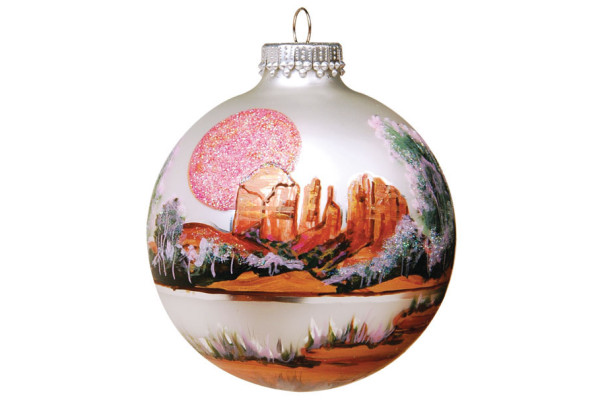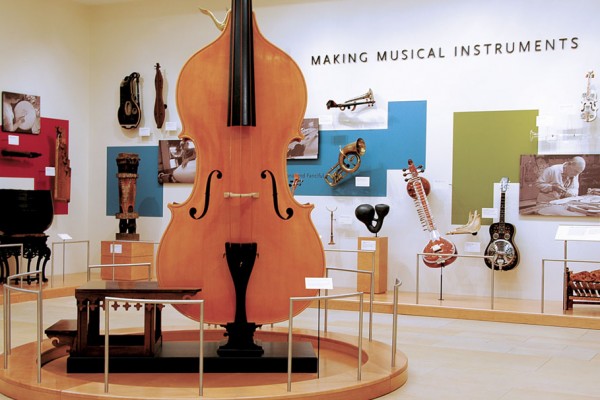Continued (page 3 of 3)
“Trading Post-era weavings are always going to be in demand because that’s what most people associate Navajo weaving with, but there is a niche for other types of weavings, especially those that are more contemporarily influenced,” says Melissa. “Within the same category as Germantown you’ll find saddle blankets, two-faced rugs [ed. rugs that have different patterns on each side; Melissa’s mom, Lola Cody, is one of only a handful of weavers that can do these], circle rugs, twill and raised-outline rugs – other techniques that deviate from the two-heddle tapestry.”
Style isn’t the only thing changing in the world of Navajo weaving. Though weaving is traditionally considered a form of women’s artwork, Lena says her sons have all woven once, and Melissa had a brother who wove a rug in junior high school. “I think 10 or 15 years ago, men might have been looked down on for weaving, but now there are male weavers receiving recognition for breaking that taboo boundary,” says Melissa.
When the conversation turns to the topic of mistakes, Lena and Melissa say they’re a fact of life. The artists do make mistakes – just as many at home alone as when weaving in public, says Lena – but they can be removed. Lena and Melissa are both adamantly against destroying a rug with too many mistakes. “They are so time consuming and there’s so much that goes into the production of the material itself,” says Melissa. “Also, it’s wool, and we have that connection within our culture that you don’t waste anything – even when we butcher, we don’t waste any part of the animal. We carry those same values with our material. We have a respect for it.”
So what is it about weaving that keeps both women in front of the loom for so many hours?
“I think it is meditative,” says Lena. “You forget about everything else. Your focus is on what you’re designing. There are days when I need to get away from it – my kids want to go somewhere, and they are tired of me sitting here.”
“It’s therapeutic, but it can also be somewhat tumultuous because you’re sitting there with your own thoughts, even if you have music or a movie on,” says Melissa. “Your attention has to be focused on your piece just because of the attention the technique requires.”
Melissa also sees weaving as a way of communicating and connecting with elder family members, but the same could be said about communicating with collectors and other cultures. “My grandma doesn’t speak English – I’m connecting with her through textiles.”
Garland’s Navajo Rugs
Navajo weavers are national treasures,” says Steve Mattoon, manager of Garland’s Navajo Rugs in Sedona. “They have been creating amazing art for several hundred years, and it continues to evolve. The public should recognize how special weavers are to our country, to the Southwest and to Arizona.”
Steve has been working at Garland’s since 1981, and he’s witnessed the evolution of Navajo textiles firsthand. Bill Garland and his son, Dan, opened the rug shop in 1976 in the same spot where it still stands at the intersection of State Route 179 and Schnebly Hill Road (411 SR 179; 928-282-4070). Word quickly spread among weavers living on the Navajo Reservation that the Garlands were paying top dollar for quality weavings – Martha Schultz, Lena Williams’ mother, began selling her weavings to Garland’s around 1980. Today, the gallery represents several hundred artists (some as young as 10) and includes an antique room filled with 19th century Navajo blankets and early 20th century rugs.
Steve says weavers established regional rug patterns in the early 20th century, and books written about Navajo weavers emphasized those styles. While it’s not taboo for an artist from Chinle to weave a Ganado pattern, Steve concedes that some collectors only want rugs from weavers who are from the region of their design. Yet just as young weavers are beginning to experiment with different patterns, collectors are becoming more interested in modern textiles. In the 1980s, as the Navajo people began leaving what is now the Hopi Reservation, colorful and asymmetrical styles such as Newlands and Blue Canyon began to emerge.
“There always has been and always will be rugs that don’t fit into specific categories,” says Steve. “Now collectors are more open to the expression of the weaver. Rugs are being looked at and appreciated as art. Collectors aren’t as concerned with the region.”
Steve uses terms like “tapestry” and “textile” as often as he uses the word “rug” because he believes “rug” is a bit of a misnomer. While there are still weavers who create large, tightly woven rugs meant for the floor, most collectors tend to display Navajo rugs on walls the same way you would hang a painting. “There’s a reverence involved,” says Steve. “Buyers don’t want to walk on the rug; they want to give it a place of honor.”
After speaking to Lena and Melissa and learning that they can spend up to one year on one rug, the price of a weaving becomes easier to understand. But Steve is quick to caution that rugs are available in a wide range of prices and a variety of sizes. He also points out that, as with Native American jewelry, the market for fake rugs has exploded in recent years. Rugs that are made overseas and sold as authentic Navajo tapestries can be found all over the Southwest. “The best thing you can do is buy from a reputable dealer and educate yourself before you purchase,” he says.
MORE NATIVE AMERICAN ARTISTS: Navajo silversmiths, Hopi katsina carvers, Acoma potters, Hopi potters, jewelers and basket makers, Zuni jewelers and a stone-fetish carver, Navajo sandpainters



